Water Productivity Talks webinars | 2020
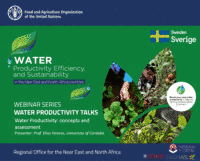
Water Productivity: concepts and assessment
In this webinar, Elias Fereres (Professor, University of Cordoba) begins the webinar with general global trend in water resources development for agriculture and in increasing irrigated area in contrast with decreasing water allocated for irrigation. He defines water productivity (WP) as production per unit water input and provides variations of water productivity expressed from different scales and perspectives such as biophysical and economic WPs. This is further explained by introducing the concepts of marginal water productivity (derivative of Yield-ET line) and how it can be used to find optimum WP value for some crops. Moreover, the equation of the water productivity gap is mentioned in addition to the methods of acquiring the components of the equation such as potential yield, actual yield, potential consumptive use, actual consumptive use. This is followed by an introduction into the different models used to determine water productivity in addition to the challenges of variability and uncertainty that such models experience. This is concluded with the applications of remote sensing on water productivity.

Cordova-ET webinars:
In a series of four webinars, Dr. José Antonio Jiménez Berni from IAS-CSIC, Spain, presents the COnductance Recording Device for Observation and Validation of EvapoTranspiration (CORDOVA-ET).
A library with protocols, guidelines and recordings are available in the web-based created to provide a way to communicate, cooperate and find solutions to any question related to the assembling, management, deployment, data acquisition and data analysis of the energy balance system CORDOVA-ET.
This sub community: https://dgroups.org/fao/waterproductivity/cordova_et is created for discussion and exchange between CORDOVA/ET users and ET network managers.
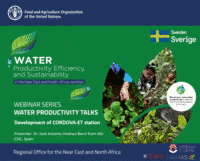
Development of CORDOVA-ET station (approach, objectives, components, and present status
The CORDOVA-ET is a set of different components and instruments designed to record micrometeorological variables required for the calculation of evapotranspiration (ET) using the energy balance (EB) method. It has been developed by the University of Cordoba (UCO) and the IAS-CSIC as part of the SIDA-FAO project. After initial testing efforts for several months, prototypes of the CORDOVA-ET systems have been deployed in seven participating countries.
In a series of four webinars, Dr. José Antonio Jiménez Berni from IAS-CSIC, Spain, presents the COnductance Recording Device for Observation and Validation of EvapoTranspiration (CORDOVA-ET).

Installation of the C-ET station (assembly, field requirements and checks).
The device is based on industrial-grade, commercial off-the-shelf (COTS) sensors with much lower costs than research-grade sensors, typically used in scientific applications until now. It has been designed to be easily replicated using manuals licensed as Creative Commons Non-Commercial. The sensors, solar power and wireless communications employed by this technology require certain conditions at the site of installation. A full CORDOVA-ET system (four nodes and the base station) will be placed in a homogeneous area with no apparent crop issues. For standardization of the measurements, the height of the weather station and the air temperature and infrared will be recorded.
In a series of four webinars, Dr. José Antonio Jiménez Berni from IAS-CSIC, Spain, presents the COnductance Recording Device for Observation and Validation of EvapoTranspiration (CORDOVA-ET).
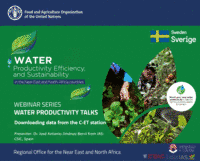
Downloading data from the C-ET station
This webinar elaborates on a web-based tool created for downloading the data from the CORDOVA-ET system in a more practical way. Whereas Grafana tool offers some basic visualisation and analysis, the new “Cordova-dash.herokupp” application intends to facilitate data download and formatting. Once you access, you can select the Deployment and date range as well as the format to download CSV files.
In a series of four webinars, Dr. José Antonio Jiménez Berni from IAS-CSIC, Spain, presents the COnductance Recording Device for Observation and Validation of EvapoTranspiration (CORDOVA-ET).
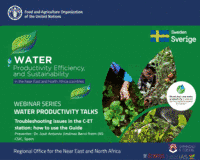
Troubleshooting issues in the C-ET station: how to use the Guide
As with any prototype under development, there are issues in the functioning of the CORDOVA-ET that arise and must be resolved. The troubleshooting guide aims at helping the station users with some of the common issues reported by the different countries. The guide is structured in different chapters focusing on the main components of the system.
In a series of four webinars, Dr. José Antonio Jiménez Berni from IAS-CSIC, Spain, presents the COnductance Recording Device for Observation and Validation of EvapoTranspiration (CORDOVA-ET).
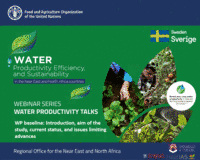
WP baseline: Introduction, aim of the study, current status, and issues limiting advances
Water scarcity for irrigated agriculture is becoming the norm in the arid and semi-arid zones, and there is a need for a paradigm change. Instead of increasing productivity per unit land area, the primary goal should be to sustainably increase production per unit of water consumed per unit land, i.e., to increase water productivity (WP).
To improve WP it is instructive to determine the current status of the WP in a given system (herein called actual WP) by establishing a baseline. Also, to determine the WP gap, there is a need to define a theoretical maximum or potential WP value that can be achieved under ideal conditions. This information is essential to have a realistic picture of every situation before proposing WP improvement measures.
In the context of the Sida project, a detailed and systematic review of the existing data about the WP status at country level has been conducted for each of the member countries. As in all systematic reviews, such review also this one started with a specific question that was addressed in a structured manner:
What is the current status of the biophysical and economic WP at country level?
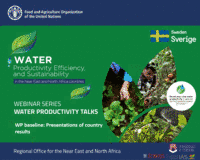
WP baseline: Presentations of country results
The researchers participating in the GCP/RNE/009/SWE project presented a state-of-the-art review of the WP in their countries. The conclusions and research challenge they obtained are the following:
Palestine:
- The literature aimed to estimate the WP in Palestine is very limited.
- Only the new scientific literature reported and estimated the real value of biophysical and economic WPET.
- The limitation of using the concept of WPET, as an indicator and as a parameter in decision-making models and tools is hindering the reallocation of water resources among various economic sectors.
- Although water productivity in the agricultural sector may be lower than the productivity in other sectors, the social and environmental values are very important to the rural communities and to society; this should be considered in future research. In addition to this, this why technical and institutional capacity building is needed for all stakeholders on the vertical and horizontal dimensions.
Iran:
- Some studies have been performed on an experimental farm or for one crop season. So, their results may be far from the truth.
- Government statistics and the results of their studies are low or secondary data is not made available to researchers.
- In some studies, the volume of water used to irrigate is not presented.
- Economic productivity studies are inaccurate due to the variability of prices and costs in different years and places and research is not practical in nature.
- Farmers do not use the results of studies and strategies provided to improve productivity on their farms. There is not active engagement between farmers and academics.
- Special recommendation: water accounting should be used, training irrigation to water users, maximum use of the private sector’s capacity, measures and strategies to enhance water productivity will help balance the aquifer provided that water harvesting is controlled and monitored, the participation of water users, water productivity training for smallholder farmers and beneficiaries, pilot training of pioneer farmers for smallholder farmers, cultivation pattern for all lands with the aim to obtain reasonable income per hectare and set up the Management Development Document of water and land.
Egypt:
WP value is affected by the amount of irrigation water and the crop yield produced by this amount of water. The results of this study indicated that:
1. With wheat:
a. WPIRR values were higher in Lower Egypt than that Meddle or Upper Egypt, while in WPET values in Meddle Egypt were higher.
b. Corrugation planting method was better than basin method especially with three irrigation during the growing season, since it gave higher WP value.
c. WP values were higher with drip irrigation system than sprinkler or surface system.
d. WP value was higher with 50% SMD than 25 or 80% in Meddle Egypt, but 25% SMD was better in Upper Egypt.
e. Application of 90kg N/ha gave the highest WP value.
2. With Rice:
a. Broadcasting planting methods gave higher WP value than transplanting.
b. WP with 9-day irrigation was higher than that with 6-day interval, while WP value with 3cm irrigation water depth was higher than 5 or 7 depth.
3. With Sugar Beet:
a. WP value with 30-55% SMD was higher than that with 55-70 % or 80-85%. Also, application of 90 kg N/ha gave WP value higher than with 30 or 60kg n/ha.
4. With Clover:
a. Irrigation cut-off at 90% of field length gave higher WP value.
b. Dry planting was better than wet traditional planting.
Jordan:
Studies differ mainly in:
- Determining the economic returns from the yield and in determining water amounts.
- Data sources and year (simulated data, actual measurements, data from survey or data from statistics).
- Neglecting or considering the farming system (greenhouses or open fields), location, growing month/date and trees’ varieties.
- Previous studies did not provide sufficient information about the methods and inputs they used to predict EWP and calculated ET.
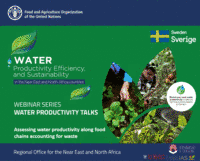
Assessing water productivity along food chains accounting for waste
The agricultural value chain includes all the activities involved in the “farm-to-fork” pathway, which transforms physically the commodity using inputs and services from several suppliers at different points along the chain.
Food losses are mainly caused by the functioning of the food production and supply system. Around half of the losses could be prevented with more efficient supply chains. Reducing food loss and waste is essential to improve the efficiency and sustainability of food value chains and reduce the sector’s vulnerability to climate change.
An assessment of the water productivity along the different functions of the value chain is needed to increase water productivity along the different stages of the food value chain. In this webinar, a series of equations and an advanced methodology is explained to estimate the water productivity and economic water productivity in each step along the value chain.
Speaker: Guillermo Donoso Harris
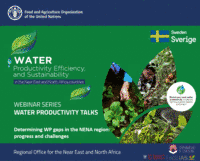
Determining WP gaps in the NENA region: progress and challenges
In the past, the focus of the agriculture was on the production, then it was shifted to land productivity, due to the limited land resources. Nowadays, in water scarcity situations, the focal point is the outputs per unit water used, and we use the Water Productivity (WP) as an indicator of the returns per unit water consumed.
This webinar starts with an introduction and the definition of the concepts of WP and Marginal WP, and discusses how can it help us in improve the efficiency of water used in the farming. This is concluded with the review of the state of the WP studies in NENA countries: what has been achieved so far, where we are at, and what needs to be done to complete the work.
Speaker: Elías Fereres
